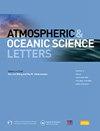中国高死亡率干热事件的增加与大西洋多年代际涛动的相变有关
IF 3.2
4区 地球科学
Q3 METEOROLOGY & ATMOSPHERIC SCIENCES
引用次数: 0
摘要
涉及多个气象要素的复合极端气候事件通常比单要素极端气候事件对环境和人类健康的影响更为严重。然而,目前多因素复合极端事件的定义是从气象和统计角度提出的,没有整合卫生数据,结论对指导健康风险预防的实用性较差。利用中国278个区县的日死亡数据和温湿度数据,确定了中国高死亡风险复合极端事件的阈值,探讨了1979 - 2021年中国高死亡风险复合极端事件发生频率的年代际变化及其驱动机制。结果表明:2000年以后,中国HMHD年频率显著增加,主要发生在夏季(6、7、8月)。中国西北至西部地区(新疆、内蒙古、甘肃)和西南至长江以南地区(四川、湖北、湖南、江西、福建、贵州、云南)的平均气温增加了10天。研究发现,hhd频率的年代际突变可归因于大西洋多年代际振荡由负相位向正相位的转变,影响了丝绸之路遥相关。摘要目前对复合极端事件的定义主要从气象和统计学角度出发, 未能结合健康数据, 使相关研究在指导健康风险预防方面的实用性较差. 本研究利用中国死亡数据和温湿度数据,识别了中国高死亡风险的复合极端干热事件(HMHDs)的阈值,并探讨了HMHD频率的年代际变化及其驱动机制。【中文翻译】:中文翻译:中文翻译:2000年1月1日。本研究可为气候变化导致的健康风险防控提供参考依据.本文章由计算机程序翻译,如有差异,请以英文原文为准。

The increase in hot–dry events with a high risk of mortality in China associated with the phase transition of the Atlantic Multidecadal Oscillation
Compound extreme climate events involving multiple meteorological elements usually have a more severe impact on the environment and human health than single-element extreme events. However, the current definition of multi-element compound extreme events is proposed from meteorological and statistical perspectives, without integrating health data, making the conclusions less practical for guiding health risk prevention. This study identified the threshold for hot–dry compound extreme events with high mortality risks (HMHDs) in China, using daily mortality data and temperature–humidity data from 278 districts or counties, and explored the interdecadal change and driving mechanisms of HMHD frequency in China from 1979 to 2021. The results show a significant increase in annual HMHD frequency in China after 2000, mainly occurring in summer (June, July, August). The northwestern to western regions of China (Xinjiang, Inner Mongolia, Gansu), and from the southwestern to the areas south of the Yangtze River (Sichuan, Hubei, Hunan, Jiangxi, Fujian, Guizhou, Yunnan), experience an increase of >10 days. The authors find that the interdecadal abrupt change in HMHD frequency can be attributed to the shift of the Atlantic Multidecadal Oscillation from a negative to a positive phase by affecting the Silk Road teleconnection.
摘要
目前对复合极端事件的定义主要从气象和统计学角度出发, 未能结合健康数据, 使相关研究在指导健康风险预防方面的实用性较差. 本研究利用中国死亡数据和温湿度数据, 识别了中国高死亡风险的复合极端干热事件 (HMHDs) 的阈值, 并探讨了HMHD频率的年代际变化及其驱动机制. 结果显示, 中国西北地区, 西南地区和江南地区的HMHD频率平均每年都超过10 天. 2000年后, 中国HMHD频率显著增加, 主要发生在夏季. 驱动机制分析表明, HMHD频率的年代际变化可以归因于大西洋多年代际振荡由负相位转变为正相位. 本研究可为气候变化导致的健康风险防控提供参考依据.
求助全文
通过发布文献求助,成功后即可免费获取论文全文。
去求助
来源期刊

Atmospheric and Oceanic Science Letters
METEOROLOGY & ATMOSPHERIC SCIENCES-
CiteScore
4.20
自引率
8.70%
发文量
925
审稿时长
12 weeks
 求助内容:
求助内容: 应助结果提醒方式:
应助结果提醒方式:


